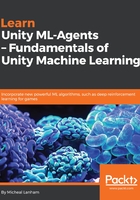
ML uses in gaming
Unity has embraced the idea of incorporating ML into all aspects of its product and not just for use as a game AI. While most developers may try to use ML for gaming, it certainly helps game development in the following areas:
- Map/Level Generation: There are already plenty of examples where developers have used ML to auto-generate everything from dungeons to realistic terrain. Getting this right can provide a game with endless replayability, but it can be some of the most challenging ML to develop.
- Texture/Shader Generation: Another area that is getting the attention of ML is texture and shader generation. These technologies are getting a boost brought on by the attention of advanced generative adversarial networks, or GAN. There are plenty of great and fun examples of this tech in action; just do a search for DEEP FAKES in your favorite search engine.
- Model Generation: There are a few projects coming to fruition in this area that could greatly simplify 3D object construction through enhanced scanning and/or auto-generation. Imagine being able to textually describe a simple model and having ML build it for you, in real-time, in a game or other AR/VR/MR app, for example.
- Audio Generation: Being able to generate audio sound effects or music on the fly is already being worked on for other areas, not just games. Yet, just imagine being able to have a custom designed soundtrack for your game developed by ML.
- Artificial Players: This encompasses many uses from the gamer themselves using ML to play the game on their behalf to the developer using artificial players as enhanced test agents or as a way to engage players during low activity. If your game is simple enough, this could also be a way of auto testing levels, for instance. We will explore an example of using ML to play a game in Chapter 5, Playing the Game.
- NPCs or Game AI: Currently, there are better patterns out there to model basic behavioral intelligence in the form of Behavior Trees. While it's unlikely that BTs or other similar patterns will go away any time soon, imagine being able to model an NPC that may actually do an unpredictable, but rather cool behavior. This opens all sorts of possibilities that excite not only developers but players as well. We will look at ways of modeling behavioral patterns using ML in Chapter 6, Terrarium Revisited – Building A Multi-Agent Ecosystem.
Our interest in this book will be in the area of artificial players and the game AI, as it tends to be the most broad topic in scope. The reader is encouraged to search out the other areas mentioned in the preceding list on their own and as/when they relate to their own project.
It is highly recommended that you take a course, read a book, or watch a video on Data Science. The area of data science deals primarily with Supervised and Unsupervised Training on ML against known datasets. However, you will or should learn data scrubbing, data labeling, the mathematics of ML, and calculating errors to name just a few important concepts. Having a background in Data Science will help you model problems as well as help you uncover possible issues when things don't work as expected.
That overview of ML certainly won't rival any Data Science course, but it should get us started for the rest of the good stuff starting in the next section, where we start looking at ML in action with Unity ML-Agents.